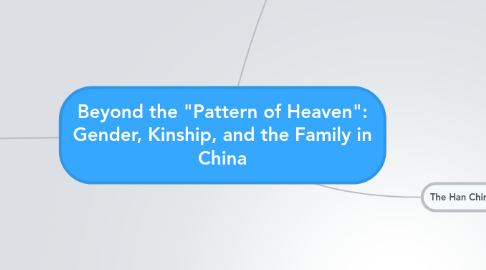
1. Alternate Models of Kinship and The Family in China
1.1. The Dai
1.1.1. Also known as the Tai-Lue Chinese
1.1.1.1. They are a Tai-speaking group of about 300,000 people in China's southwestern province of Yunnan.
1.1.2. Unlike the Han Chinese, the Dai's kinship is bilateral and follows both the man and woman's lineage.
1.1.2.1. Surnames are identifiable by sex: all male names begin with Ai and all female names begin with Yi.
1.1.3. When it comes to marriage, the groom must live with the bride's family for three years and work for them to prove himself.
1.1.3.1. Divorce is also unlike the Han Chinese. Women have legal protection and are able to keep their children.
1.2. The Lahu
1.2.1. They are a Tibeto-Burman speaking group that live in the regions of Myanmar, Laos, Thailand, Vietnam, and China.
1.2.2. The Lahu strongly believe in gender equality.
1.2.2.1. "Chopsticks only work in pairs." (page 359)
1.2.3. The Lahu kinship is bilateral, unlike the Han Chinese.
1.2.4. The husband and wife are expected to split the workload when it comes to career and home.
1.2.4.1. Father is expected to participate in all stage of his wife's pregnancy.
1.2.4.1.1. Instead of a midwife, the father delivers the children.
1.3. The Mosuo
1.3.1. The Mosuo reside in southwest China.
1.3.2. Their kinship is considered to be matrilineal, unlike the Han Chinese.
1.3.3. They don't believe in the institution of marriage, but they have what is called a "walking marriage."
1.3.3.1. These may be initiated by the man or woman and refused by the man or woman. It is never forced.
1.3.3.2. There are no terms for the "inlaws."
1.3.3.3. Children live in the household that they are born in which is often the mother's home.
2. Introduction
2.1. China is often seen as having a culture of extreme male dominance with women seen but not heard.
2.2. "China is hardly a homogenous society..." (page 352)
2.3. Han is the majority ethnic group (92%) while the rest of China is compiled of 55 different minority groups.
2.3.1. The 55 other groups have very different customs and traditions from the Han Chinese, which is more patriarchal.
3. The Han Chinese
3.1. Origin
3.1.1. Han Chinese began during the Han Dynasty from 206 BC to 220 AD.
3.2. Confucianism
3.2.1. Confucianism allows anyone to join as long as they follow the customs and traditions.
3.2.2. Filial Piety
3.2.2.1. "Confucianism's emphasis on filial piety is not limited to the relationship between sons and fathers, but rather requires that children of both sexes honor their father and mother equally." (page 353)
3.2.2.1.1. Despite mothers being include, sexism and double standards are heavily present.
3.2.3. Emphasis on five relationships: ruler/minister, father/son, elder brother/younger brother, husband/wife, and friend/friend.
3.3. Patrilineal Kinship
3.3.1. "The very limited role played by women is echoed in the Chinese practices of ancestor worship and patrilineal kinship." (page 353)
3.3.1.1. There are patrilineal surnames in Han Chinese culture.
3.3.2. Women are only noted in family histories as wives, daughters, and mothers.
3.3.2.1. If a woman was divorced or widowed and then remarried then she was removed from the family history.
3.3.2.2. Women often marry outside of their community, leave them without a network.
3.4. Life Stages of the Han Chinese Woman
3.4.1. Women in Han Chinese traditions are in an inferior position.
3.4.2. "Women should defer to men throughout their lives: first to their fathers, then to their husbands, and upon widowhood to their sons." (page 354)
3.4.3. Many baby girls faced the danger of infanticide because they weren't seen as productive as boys, especially to poor families.
3.4.4. Marriage is seen as the most important life event for a Han Chinese woman.
3.4.4.1. Divorce was seen as one of the worse if it were to ever happen.
